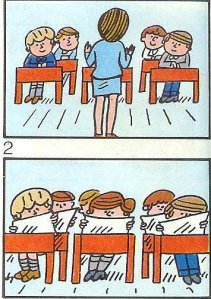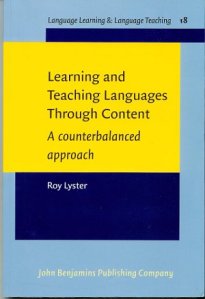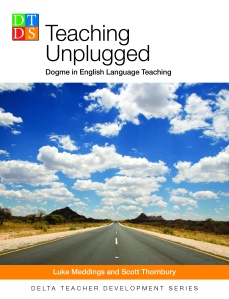 Question: where does the input come from in an approach like task-based learning, or Dogme, where there is no syllabus of forms as such, and in which any focus on form is incidental?
Question: where does the input come from in an approach like task-based learning, or Dogme, where there is no syllabus of forms as such, and in which any focus on form is incidental?
This is the gist of the question sent to me a short while back by Anthony Elloway:
My concern about Dogme … is this – is the input rich enough?… My intuition is that, though there are advantages to working with student output, bringing more language into the class seems to be very valuable. And a coursebook – if given life by a teacher – might just do this job… Having an external syllabus/ coursebook does seem to provide a great deal of (organised) input for learners, perhaps more than the learners could produce themselves.
Good question. One possible answer is that the input comes – not just from the learners’ output – but from the texts that they (or the teacher) bring to class. Texts would certainly enrich the input quotient.
But the problem still remains that the form focus is incidental, in the sense that it is not necessarily pre-determined by a structural (or lexical or functional etc) syllabus. And not just incidental, but – with teachers whose language analysis skills are still rudimentary – it’s more likely to be accidental.
Roy Lyster, in putting the case for ‘a counterbalanced approach’ (in a book referred to in a previous post), sees a similar danger in content-based teaching (i.e. of the CLIL type), and cites research that suggests that, in content-based teaching, ‘attention to language is too brief and likely too perfunctory to convey sufficient information about certain grammatical subsystems and thus … can be considered neither systematic nor apt to make the most of content-based instruction as a means of teaching language’ (2007, p. 27).
It’s true: as teachers we know that, when a really good conversation is up and running, the last thing we want to do is wade in and correct errors or suggest better ways of saying the same thing. Yet it is precisely at these moments that, allegedly, corrective feedback is at its most effective.
 Michael Swan (2005), in a withering critique of task-based learning, makes a similar argument to Lyster’s, but even more forcefully:
Michael Swan (2005), in a withering critique of task-based learning, makes a similar argument to Lyster’s, but even more forcefully:
I suggest that naturalistically-biased approaches are, in important respects, pedagogically impoverished, favouring the development of what is already known at the expense of the efficient teaching of new language.
That is to say, where there is no pre-selected input, the existing ‘pool’ of language just goes round and round. He adds:
It is difficult to see how, in many classrooms, interaction can reliably promote the acquisition of new material during task performance. Unless the teacher is the interlocutor, task-based interaction may more easily uncover gaps than bridge them.
Of course, there is no reason why the teacher can’t be the interlocutor, and a Dogme approach has always argued for the teacher being a co-participant in the conversation. But, clearly, the teacher’s ability to provide optimal input is a function of class size, not to mention their classroom management and language management skills.
 But can’t learners provide each other with input? Swan accepts that there is some evidence that learners can pick up new language items from one another, but rejects this as being a sound basis for a methodology: ‘If one was seeking an efficient way of improving one’s elementary command of a foreign language, sustained conversation and linguistic speculation with other elementary learners would scarcely be one’s first choice’.
But can’t learners provide each other with input? Swan accepts that there is some evidence that learners can pick up new language items from one another, but rejects this as being a sound basis for a methodology: ‘If one was seeking an efficient way of improving one’s elementary command of a foreign language, sustained conversation and linguistic speculation with other elementary learners would scarcely be one’s first choice’.
Nor, for that matter, would being subjected solely to teacher-fronted grammar explanations be one’s first choice either, especially where the grammar being explained has been selected arbitrarily from a pre-established syllabus, and bears little or no relation to one’s communicative needs.
Hence Lyster’s argument for a counterbalance: ‘Both proactive and reactive approaches need to be counterbalanced in complementary ways’ (p. 137).
How? Lyster argues for the inclusion, within a meaning-driven approach, of more form-focused options. These would include explicit attention to form, through noticing and awareness tasks, plus practice activities for production, and explicit feedback on error.
 Would the inclusion of form-focused interventions such as these circumvent the need for a coursebook and, by extension, a pre-determined syllabus of grammar McNuggets? I hope so. But, for those teachers who opt for a more experiential methodology, such as Dogme, a counterbalanced approach may require more rigour, and more finely-honed teaching skills, than are normally required either teaching from a coursebook or simply chatting with the students.
Would the inclusion of form-focused interventions such as these circumvent the need for a coursebook and, by extension, a pre-determined syllabus of grammar McNuggets? I hope so. But, for those teachers who opt for a more experiential methodology, such as Dogme, a counterbalanced approach may require more rigour, and more finely-honed teaching skills, than are normally required either teaching from a coursebook or simply chatting with the students.
Or is the term ‘input’ itself a non-starter? Isn’t it a relic of a mechanistic, computational metaphor of the mind that is giving way to a more ecological one? Shouldn’t we be thinking less of input as such, and more about the learning opportunities that become available in authentic language use – in other words, the affordances (for which see the previous post)?
References:
Lyster, R. (2007) Learning and Teaching Languages through Content: A Counterbalanced Approach. Amsterdam: John Benjamins.
Swan, M. (2005). Legislation by Hypothesis: The Case of Task-Based Instruction. Applied Linguistics, 26 (3): 376-401.
Illustrations from Oxenden, C., and Seligson, P. (1996). English File 1: Students’s Book. Oxford: Oxford University Press.










Recent comments